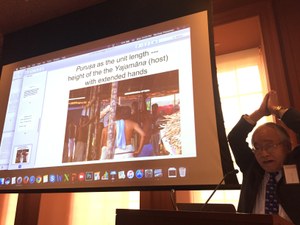ISAW hosts conference “Cosmos, East and West: Astral Sciences in South and East Asia and Their Interaction with the Greco-Roman World”
Last Monday, February 27, ISAW hosted a conference entitled Cosmos, East and West: Astral Sciences in South and East Asia and Their Interaction with the Greco-Roman World. The conference was organized by ISAW Visiting Research Scholar Bill Mak and ISAW Associate Professor of East Asian Art and Archaeology Lillian Tseng.
Six scholars -- Marko Geslani (Emory), W. Randolph Kloetzli, Bill Mak (Kyoto), David Pankenier (Lehigh), Michio Yano (Kyoto Sangyo), and Kenneth Zysk (Copenhagen) presented their latest research on various aspects of the multifaceted traditions of astral science developed in ancient Greece, India and China. The presentations covered a wide range of interrelated topics including astronomical observation, astral rituals, divination and physiognomy.
Yano presented his paper "The Size of the Universe in Indian Astronomy" and demonstrated to the audience how sizes were measured in Vedic India.
The comments by Stephan Heilen (Osnabrück), David Pankenier (Lehigh), Alexander Jones (ISAW), Pia Brancaccio (Drexel),Nathan Sivin (U Penn), and Claire Bubb (ISAW) provided a fascinating counterpoint to the presentations as Classicists, Indologists, Sinologists shared their insight on subjects and materials of considerable importance in the study of the ancient world, examined however from very different angles and within different academic disciplines.
Pankenier commenting on Kloetzli’s paper "Ptolemy and the Indian Religious Cosmologies," pointing out some striking similarities from Chinese sources.
Alexander Jones gave a guided tour of the exhibition Time and Cosmos in Greco-Roman Antiquity to the participants of the conference.
In conjunction with the conference, participants had the opportunity to examine an unusual Japanese star maṇḍala (14-15th century?) currently in display at the Metropolitan Museum of Art.
Viewing of a Japanese star maṇḍala currently in display at the Metropolitan Museum of Art
A number of presenters (Geslani, Mak, Yano, Zysk) benefited also from the opportunity to spend a week prior to the conference to examine the unedited Sanskrit manuscripts of the Gargasaṃhitā, dated around first century AD and considered one of the oldest astral and omen texts from India with Babylonian, Greek and Vedic content. Their latest findings were presented in a workshop on February 28 and will hopefully be published later this year.
Editing of the Sanskrit manuscripts of the Gargasaṃhitā




